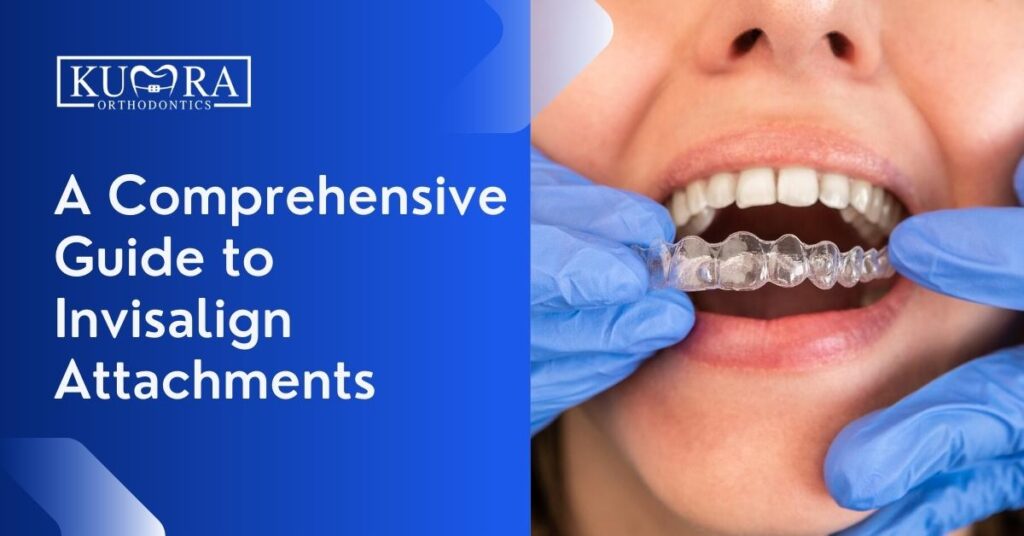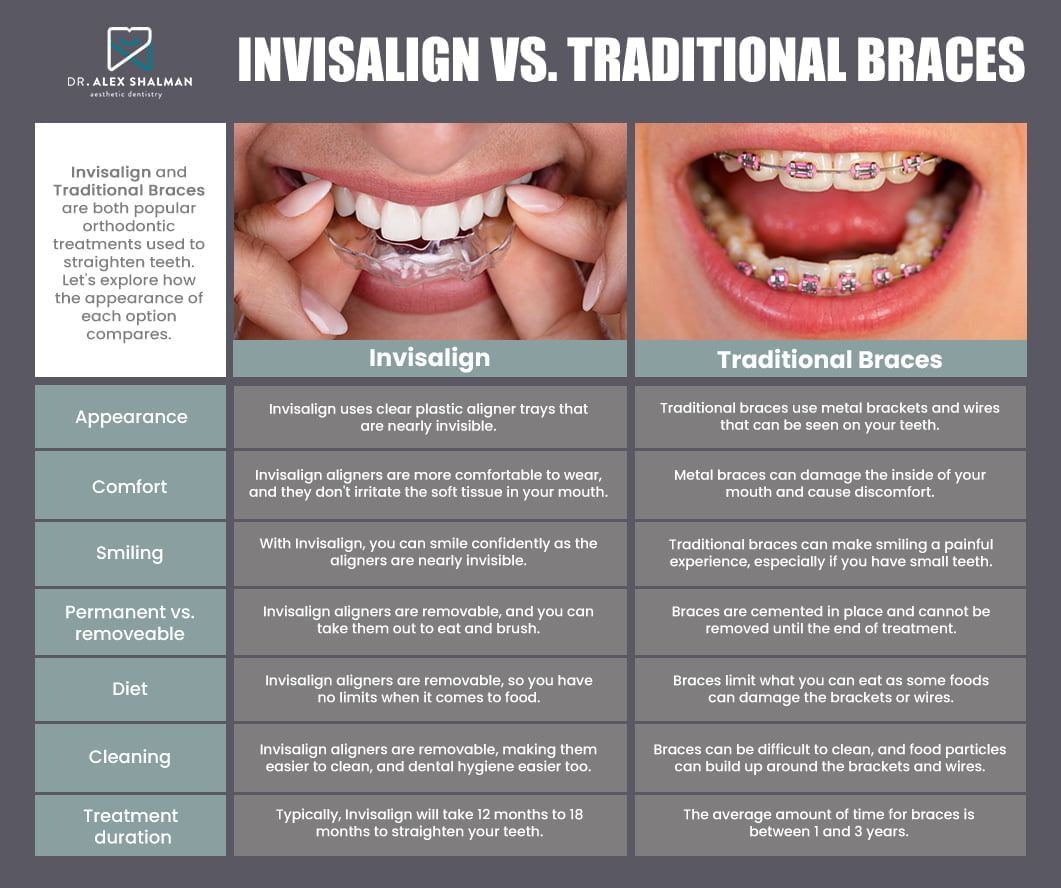Preserving Oral Health While Utilizing Invisalign: Tips for a Smooth Experience
Preserving Oral Health While Utilizing Invisalign: Tips for a Smooth Experience
Blog Article
Invisalign vs. Conventional Braces: Which Option Is Right for You?
When taking into consideration orthodontic therapy, the option between Invisalign and typical dental braces presents numerous crucial aspects that merit mindful examination. Invisalign uses a very discreet alternative with detachable aligners, while conventional dental braces supply an extra visible yet efficient remedy for serious imbalance. Each choice encompasses unique advantages and disadvantages associated with aesthetics, comfort, treatment duration, and price. Comprehending these nuances is vital for making a notified choice that straightens with your individual choices and way of living. The concern stays: which option will ideal fulfill your orthodontic demands and expectations?
Summary of Therapy Alternatives

In contrast, conventional braces include metal braces and cables that are bonded to the teeth. This technique applies continuous stress in time to achieve alignment. While effective for intricate orthodontic issues, traditional braces require regular visits for modifications and can position challenges in keeping dental hygiene due to the problem of cleaning around braces and cables.
Both alternatives have their advantages, and the choice commonly rests on certain oral problems, way of life choices, and person compliance. Ultimately, getting in touch with an orthodontic specialist is crucial for determining one of the most suitable therapy strategy customized to individual requirements. Comprehending the nuances of each option can substantially influence the total success of orthodontic therapy.
Aesthetic Factors To Consider
A considerable element affecting the option between Invisalign and conventional dental braces is the visual charm each treatment supplies. Invisalign aligners are crafted from clear plastic, making them essentially unnoticeable when worn.
On the other hand, conventional dental braces contain metal braces and cables, which can be much more visible. While developments in orthodontic technology have led to the growth of smaller sized braces and colored elastics, conventional dental braces still keep a more obvious account. For some individuals, the visibility of braces may hinder them from looking for necessary therapy.
Eventually, the selection in between Invisalign and conventional dental braces may depend upon personal choices pertaining to looks. Clients who prioritize discretion commonly favor Invisalign, while those who are much less worried regarding exposure might select standard dental braces. Understanding the aesthetic ramifications of each alternative is important for making an educated decision that lines up with one's way of living and choices.
Convenience and Convenience

In regards to comfort, Invisalign aligners are detachable, making it possible for people to enjoy their favorite foods without limitation and preserve ideal dental health. Cleaning and flossing are simplified, as the aligners can be gotten during these routines, whereas typical dental braces call for careful navigating around brackets and cords.
In comparison, standard braces demand regular modifications, making them less convenient for those with hectic timetables. In general, the convenience and benefit of Invisalign make it an enticing choice for several people looking for orthodontic therapy.
Treatment Duration and Performance
While both Invisalign and traditional braces work in correcting dental misalignments, the period of therapy can differ dramatically in between both options. Generally, Invisalign therapy can take anywhere from 12 to 18 months, depending on the complexity of the case. The clear aligners function by gradually moving teeth right into their desired placements, and normal follow-ups with an orthodontist help ensure progression remains on course.
On the other hand, typical dental braces commonly call for a longer commitment, typically varying from 18 months to 3 years. This results from their set nature and using braces and cords, which can be a lot more reliable for extreme imbalances and intricate instances (Invisalign). The therapy efficiency of standard dental braces is well-documented, as they enable specific adjustments and higher control over tooth activity
Inevitably, the choice between Invisalign and traditional braces might pivot on both the awaited treatment period and the details dental problems at hand. Consulting with an orthodontist is critical, as they can provide customized referrals based upon individual needs, making sure the chosen method aligns with preferred results and timeframes.
Cost Comparison and Insurance Coverage Alternatives
Price plays a substantial duty in the decision-making process for individuals thinking about wikipedia reference orthodontic therapy, whether opting for Invisalign or traditional dental braces. Generally, the cost of Invisalign you could look here varieties from $3,000 to $8,000, while typical dental braces usually cost in between $2,000 and $6,000. Variables affecting these costs include the complexity of the situation, the duration of treatment, and geographical location.
Several dental insurance coverage strategies give partial coverage for orthodontic treatments, however the specifics can differ extensively. Generally, conventional dental braces might be a lot more regularly covered by insurance plans compared to Invisalign, which some insurance companies classify as an aesthetic treatment.
Additionally, several orthodontic methods use adaptable layaway plan, making both treatment choices extra available. Individuals must make inquiries concerning potential financing choices and discount rates for ahead of time repayments. Examining the overall price, consisting of insurance advantages and payment strategies, is important for making a notified choice that aligns with both visual preferences and budget plan factors to consider.

Verdict
In recap, the choice in between Invisalign and traditional braces rests on several variables, consisting of aesthetic preferences, convenience, therapy duration, and cost. Invisalign uses a discreet, removable alternative that promotes oral health and nutritional flexibility, while traditional dental braces may be preferable for complex oral problems and typically come at a lower rate factor. Ultimately, consultation with an orthodontist is important to analyze specific conditions and establish one of the most suitable therapy choice for accomplishing optimal oral positioning.
When considering orthodontic therapy, the selection in between Invisalign and standard braces offers a number of vital variables that merit cautious examination.Comparing Invisalign and traditional dental braces reveals distinct treatment alternatives for orthodontic correction.While both Invisalign and standard dental braces are effective in remedying oral imbalances, the period of treatment can vary dramatically in between the two alternatives.Expense plays a substantial role in the decision-making process for individuals considering orthodontic treatment, whether deciding for Invisalign or conventional braces.In summary, the choice in between Invisalign and typical braces pivots on numerous factors, including aesthetic preferences, convenience, therapy period, and cost.
Report this page